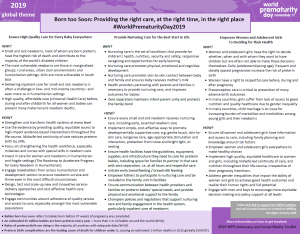
View Resource
World Prematurity Day 2019 Message Map
Ensure High Quality Care for Every Baby Everywhere
WHY
- Small and sick newborns, most of whom are born preterm, have the highest risk of death and contribute to the majority of the world’s disabled children
- The most vulnerable newborns are those in marginalized groups, rural areas, urban slum environments and humanitarian settings. Girls are more vulnerable in South Asia
- Delivering inpatient care for small and sick newborns is often a challenge in low- and mid-income countries– and even more so in humanitarian settings
- High quality, affordable care (Universal Health Care) before, during and after childbirth for all women and babies can prevent many maternal and newborn deaths.
HOW
- Strengthen and transform health systems at every level
- Use the evidence by providing quality, equitable access to high-impact evidence-based interventions throughout the life-course. Midwife-led continuity of care reduces preterm birth by 24%.
- Focus on strengthening the health workforce, especially midwives and nurses with special skills in newborn care
- Invest in care for women and newborns in humanitarian and fragile settings (The Roadmap to Accelerate Progress for Every Newborn in Humanitarian Settings)
- Engage stakeholders from across humanitarian and development sectors to ensure newborns survive and thrive even in the most difficult circumstances
- Design, test and scale-up new and innovative service-delivery approaches and cost-effective health-care technologies
- Engage communities around adherence of quality service and access to care, especially amongst the most vulnerable populations
Provide Nurturing Care for the Best Start in Life
WHY
- Nurturing care is the set of conditions that provide for children’s health, nutrition, security and safety, responsive caregiving and opportunities for early learning
- Nurturing care promotes physical, emotional and cognitive development
- Nurturing care promotes skin-to-skin contact between baby and family and ensures baby receives mother’s milk
- Health providers partnering with parents and families is necessary to provide nurturing care, and improves outcomes for babies
- Zero separation maintains infant-parent unity and protects the family bond
HOW
- Ensure every small and sick newborn receives nurturing care, including early, essential newborn care
- Implement simple, cost-effective ways to promote developmentally supportive care, e.g. gentle touch, skin-to-skin care, kangaroo care, age-appropriate stimulation and interaction, protection from noise and bright light, or nesting
- Ensure health facilities have the guidelines, equipment, supplies, and infrastructure they need to care for preterm babies, including space for families to partner in that care with zero separation, i.e. at all hours and respectful care
- Initiate early breastfeeding / breastmilk feeding
- Empower fathers to participate in nurturing care and be included in the family unit in facilities
- Ensure communication between health providers and families on preterm babies’ special needs, and provide physical and emotional support to the family
- Champion policies and regulations that support nurturing care and family engagement in the health system, particularly inpatient care of newborns
Empower Women and Adolescent Girls to Deciding for their Health
WHY
- Women and adolescent girls have the right to decide whether, when and with whom they want to have children but are often not able to make these decisions themselves.
- Early (adolescent/young age), frequent and closely spaced pregnancies increase the risk of preterm birth
- Women have a right to respectful care before, during and after pregnancy
- Preconception care is critical to prevention of many adverse birth outcomes
- In many countries, girls suffer from lack of access to good nutrition and quality healthcare due to gender inequality
- In many countries, child marriage is an issue for increasing burden of mortalities and morbidities among young girls and their newborns
HOW
- Ensure all women and adolescent girls have information and access to care, including family planning and knowledge around risk factors
- Empower women and adolescent girls everywhere to make healthy choices
- Implement high quality, equitable healthcare to women and girls, including midwife-led continuity of care, and nutrition throughout their life-course, irrespective of their pregnancy intentions.
- Address gender inequalities that impact the ability of women and girls to achieve good health outcomes and realize their human rights and full potential
- Engage with men and boys to encourage more equitable decision-making and policy support at all levels
For related resources:
- Roadmap to Accelerate Progress for Every Newborn in Humanitarian Settings 2020-2025
- Survive and Thrive: Transforming care for every small and sick newborn